All the toys
The first thing I noticed when the new Suzuki Swift SZ4 turned up is just how much standard equipment you get.

Date: 7 November 2011 | Current mileage: 811 | Claimed economy: 56.5mpg | Actual economy: 44.9mpg
My previous Hyundai i10 was a perfectly good car. It did everything it needed to, but very little more. So when its replacement - a Suzuki Swift SZ4 arrived - I was astounded and ecstatic at the level of equipment it offers.
As it’s a top of the range model, there’s electrically adjustable and heated door mirrors, electric windows front and rear, Bluetooth, USB connectivity, automatic climate control, cruise control, steering wheel mounted audio controls, keyless start - and my very favourite, keyless entry.
With the i10 it was necessary to insert the key into the door to unlock it, something that’s increasingly uncommon thanks as remote central locking is the norm on most modern cars. But the little Swift goes one stage further and allows you to unlock and start the car without even removing the key from your pocket.
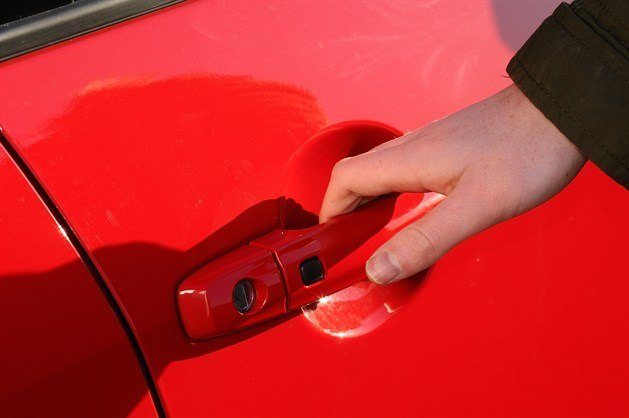
So long as you’ve got the key on you, all you need to do is press a little black button on the door handle and it unlocks. Press once to unlock the driver’s door, twice for the others. When you get out, you only need to press the black button again and the doors all lock. It’s so easy. While many systems do the same, the Swift offers the added peace of mind of letting you check the car is locked without automatically opening again until you press the black button. Genius!
The other useful piece of standard gear fitted to the SZ4 model is cruise control. It’s not a particularly complex system; there’s no radar, sonar, or any other space-age nonsense to keep you the correct distance from other cars, but it does the job. It’s not often that cars in this class come with cruise control – it’s usually the reserve of big motorway cruisers – and it’s a welcome piece of kit.
It’s at its most useful in tedious 50mph zones. Set it at 49 and then you don’t have to worry about speeding, meaning you can pay more attention to the road and less to the speedometer.
It’s not all good news though. The first impression I got when climbing inside wasn't overwhelming. The cabin is attractively styled, but it doesn't come up to scratch in terms of quality. The plastics appear a little flimsy and the doors clatter shut, rather than closing with a reassuring thud. It's not going to fall to bits, but it doesn’t feel as though it’s been made of the best materials Suzuki could lay its hands on.
Nonetheless, the list price of £12,895, when coupled with the generous equipment levels, makes the slightly flimsy plastics extremely easy to forgive. Running costs are low too. The 94PS 1.2-litre petrol engine returns an average claimed 56.5mpg and emits 116g/km of CO2, meaning it sits in VED band C, currently £30 a year.
So far, after about 800 miles, the average economy is 44.9mpg. Achieving the official economy figures rarely happens in real world driving and the engine still needs to loosen up a bit, but I expect that average to improve over the coming months, particularly after some long motorway trips.
What's good:
Keyless entry and go: To get into the car and get underway I just need to have the key on me. I can get in the car and get it started without getting it out of my pocket, and it makes life far easier!
And what's not:
Parcel shelf: To get into the boot you need to manually raise the parcel shelf - not unusual on a small car. But if you forget to put it down it gets in the way of your rear view, and you can't just accelerate to knock it back into place. Instead you have to stop, get out and put it back. Irritating.
Revelations
It's not uncommon for little cars to offer enjoyable driving dynamics, and expected as much from the Swift. Turns out it's a revelation.
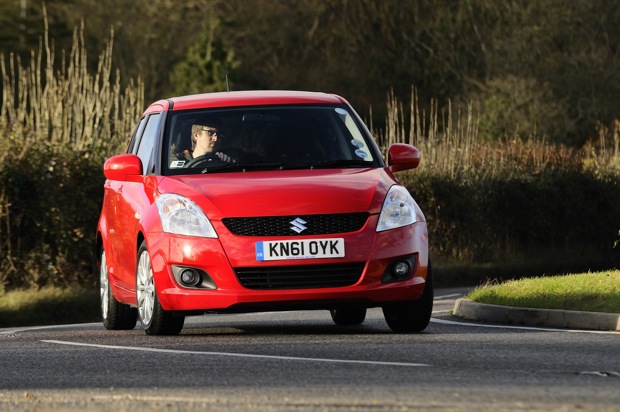
Date: 21 November 2011 | Current mileage: 944 | Claimed economy: 56.5mpg | Actual economy: 44.9mpg
I’ve always been a fan of small cars. They’re what I grew up with – when I was a child my brother had a Mk1 Ford Fiesta with Lucas spotlights and a big eagle graphic on the bonnet. One of my early cars was a Citroen Saxo VTR, known for its entertaining handling.
Having grown up in a village in the Yorkshire Dales, I’m used to the merits of a small car. The nearest roundabout to my home for the most part of my life was eight miles - and it was just as far to a set of traffic lights. Between me and them there was nothing but twists and turns, with straight stretches of road never lasting more than a few hundred yards.
Over such winding roads, larger cars tend to wallow around – they feel as heavy as they are and don’t really inspire much confidence. Smaller, lighter machines like the Swift feel much more at home – so I was expecting competence, at the very least, from the Suzuki.
What I actually found was something of a revelation. The Swift, despite a little 1.2-litre engine, is excellent fun to drive, thanks in no small part to a communicative, precise steering set-up. The turn-in (the way in which the car reacts the instant you steer) is extremely precise and immediate. There’s no delay between you making a movement of the wheel and the resulting change of direction.
It makes you feel connected to the car and - more importantly - to the road. That’s also helped by the suspension, which is fairly firm and keeps unnerving body roll at bay in tight bends. Unfortunately, while the suspension is ideal for country roads it’s far from perfect elsewhere.
Find a rough piece of tarmac and all of the lumps, bumps and potholes are relayed into the cabin with a thud. In fact, on one occasion I was convinced that I’d broken the car because of how loudly it crashed over an admittedly huge pothole, but luckily it was fine.
Back to that little engine. It’s a 1.2-litre four-cylinder and produces 94PS, which is hardly a figure to write home about. But consider the fact that about ten years ago you’d expect that from a 1.6-litre engine (My Saxo VTR produced 96PS) and it sounds a little more interesting, combining fun with frugality. All of the power arrives in a large chunk at the top of the rev range, accompanied by a sporty, addictive exhaust note.
It means that you have to push on quite hard to make the most of the engine, which is entertaining on the right road. Thanks to that high-up power delivery, the Swift is a little more relaxed in and around town and the gearing means you can drive at a quiet, steady 30mph in fourth gear, and even fifth with a clear road.
Unfortunately it’s a little loud on a motorway cruise, but that’s not the environment for which the Swift is designed, despite the fitment of cruise control. But for someone who learned to drive on twisting country lanes, the Swift is ideal.
What's good:
The steering: It's about as pointy as steering gets. It's extremely easy to drive the Swift precisely on a country lane, and it's very enjoyable.
And what's not:
Where's the Aux-In?: This is a little cruel, given the fact there's a USB port, but why's there no Aux-in? I find it much easier to set the iPod on random and just plug it in via an audio jack.
On a journey
The Swift has, so far, impressed. It's great on country lanes, packed with gear and works well in town. But what about on a long motorway trip?
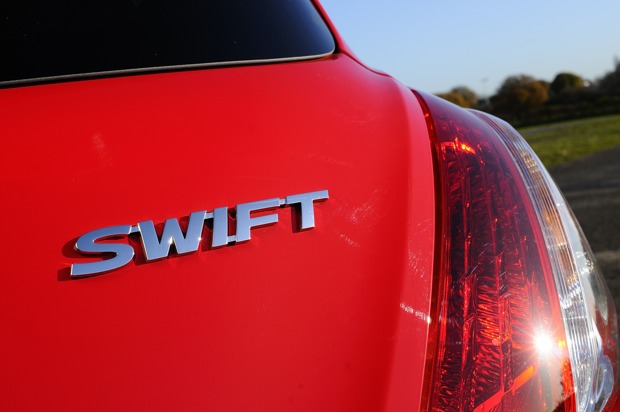
Date: 5 December 2011 | Mileage: 1698 | Claimed economy: 56.5mpg | Actual economy: 46.1mpg
The first month with the Swift was fairly uneventful in the grand scheme of things. Each journey ticked the mileage up by single digits, with trips to the supermarket, the bus stop or the next town.
It’s a good car in which to make such trips. It’s nimble, easy to drive and easy to park, but what about over a long distance? Luckily - or unfortunately, depending on perspective - all of my family live in the North East, and so to visit them I have to make a journey from London up the M1 to County Durham.
For obvious reasons I don’t make that trip every weekend, but eventually it was time to take the Swift on its first ‘proper’ journey, and it delivered mixed results.
On the one hand there’s the comfortable, easily adjustable seats, which keep numbness at bay for quite a while. There’s also the good quality audio system, which makes listening to the scores of local radio stations available on the trip much better, and there’s the cruise control, which certainly makes a four hour trip pass with ease.
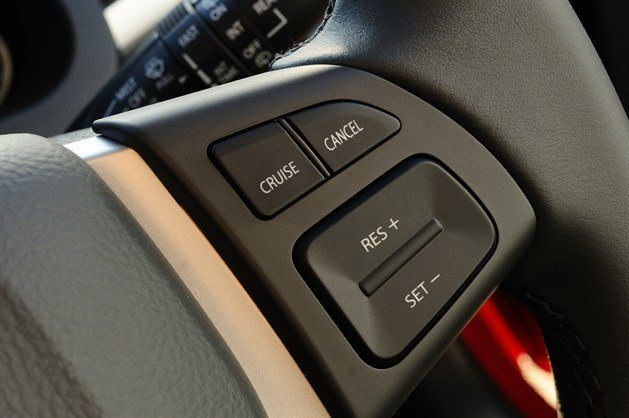
But there’s some bad points, too – most notably the noise. There’s quite a lot of tyre roar and road noise transferred into the cabin, and at a steady cruise of 70mph the rev counter sits at around 3,000rpm, so the engine isn’t exactly subdued. A longer fifth gear, or perhaps the addition of a sixth ratio, would resolve the problem – with the added bonus of improving fuel economy.
Not that fuel economy is particularly bad – the Swift is ticking its way towards 2000 miles now, so the engine has loosened up somewhat and, despite cold weather, it’s returning 46.1mpg on average. That’s short of the official 56.5mpg, but it’s not at all bad. The average in our Real Life Fuel Economy Register is a respectable 51.5mpg, and one owner has managed to beat the official figure by 1.1mpg.
Another thing that became apparent because of my long journey was the slightly awkward load space. I have a pet corn snake (make of that what you will), and he had to come with me. That meant loading his vivarium over a high lip into a fairly small boot. With the snake’s tank in the boot there was little room for anything else, and the seats only flop forward, rather than folding flat, so that made loading everything else in a bit of a struggle.

They do split/ fold though, and while they’re far from perfect there’s certainly enough space for most things, including trips to the recycling centre with an entire bin, a vacuum cleaner, several folded boxes and a case of old wine bottles...
So far the Swift has been a mixed bag. It’s not as refined as some rivals, but what it lacks in refinement it more than makes up for in character, enjoyable handling and style, and it has bags of standard equipment to boot.
What's good:
The stereo: It's crisp, clear and has steering wheel mounted controls, so I can be as lazy as I like when I want to turn it up, turn it down or mute it because there's an advert about injury lawyers on.
And what's not:
The noise: There's a lot of tyre roar at higher speeds, and the engine is loud at a motorway cruise. It gets irritating on a long motorway journey like the one I make from London to County Durham.
Disaster!
A recent minor bump opened my eyes to the amount of safety kit fitted to the Suzuki Swift, which has a five star Euro NCAP rating.
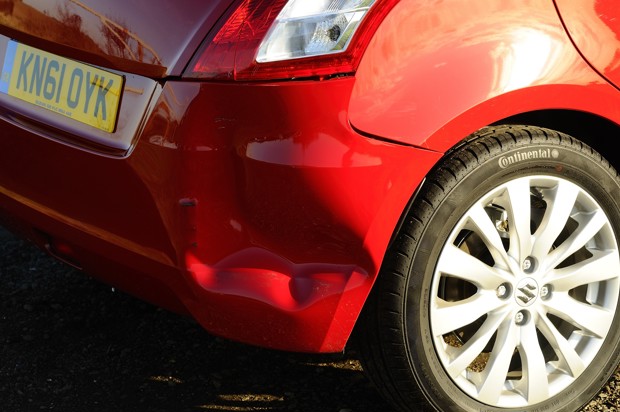
Date: 23 December 2011 | Current mileage: 1739 | Claimed economy: 56.5mpg | Actual economy: 46.1mpg
I’ve been involved in one accident before and it was on a motorbike, which meant I was the crumple zone. I wasn’t hurt, but I could very easily have been killed - and I was only travelling at 20mph. That means I have a huge appreciation for the safety offered by a modern car.
Safety equipment is good. Modern cars have lots of gear to keep occupants protected in a crash and to keep pedestrians safe if they’re hit. There’s everything from the obvious air bags to less apparent things, like the height of the bonnet and the position of the windscreen wipers.
Crumple zones are vital. If a car hits something then its crumple zones absorb most of the impact so that the energy is dissipated gradually, rather than immediately. This means the energy of the collision is absorbed by the car and not relayed to the occupants.
I recently found out just how much the rear bumper of the Swift bends under even the most minimal of stress, care of an inattentive van driver reversing out of his space without first checking his mirror.
Yes, that battle scar is the result of a collision that took place at speeds slower than a snail moves, but the spongy, energy absorbing bumpers of the Swift buckled under the weight of a long wheelbase Ford Transit.
Luckily there are insurers and I can’t fault the way in which they’ve handled the problem. The repair, too, has obviously been carried out to the highest standard and the car looks just as good as it did when it rolled off the production line. So when all is said and done, it’s not the worst thing to have ever happened.
Features like the ‘bendy’ plastic bumpers fitted to modern cars keep insurance costs down, but more important than a cheap repair is the safety of occupants in more severe accidents. Suzuki has put a lot of effort into ensuring that the Swift will protect its occupants just as well in a high speed collision as it does in a low speed one.
It scores the maximum five star score in Euro NCAP tests, with a 94% adult occupancy protection rating and 82% for children. It’s a far cry from the 80s and 90s, when small cars would fold up into oblivion in almost any crash.
There are seven airbags, including curtain airbags to protect the occupants’ heads in side collisions, and there’s ESC to keep skidding under control. The official Euro NCAP crash test video is embedded below, and you can see how all of the crumple zones and active safety systems work together in glorious slow motion.
What's good:
It's safe: A five star safety rating means that it's a very safe car, despite the fact it's so small.
And what's not:
Battle scars: After a slow-speed knock the rear bumper looked mangled for a few weeks until a repair was booked in. People seem to look at you as though you're a bad driver if your bumper is bent, no matter who was at fault!
Spot the difference
When the new Swift was launched many people - rightly - observed that it looks like the old one. So what's the difference?

Date: 6 January 2012 | Mileage: 1921 | Claimed economy: 56.5mpg | Actual economy: 46.2mpg
When the current Suzuki Swift was introduced in 2010 there was a bit of confusion. The press information may say ‘all-new’ but it looks suspiciously like the old model. That’s hardly a problem because it’s a handsome little car. Perhaps they went by the adage “if it ain’t broke, don’t fix it.”
To the untrained eye, the styling of the two models is identical, but if you catch a new Swift and an old Swift side by side you’ll notice they’re very different indeed. The new model is slightly taller, slightly wider and slightly longer.
It’s got bigger, more angular head lights and tail lights, and a little ‘rump’ at the rear, like a toned down Megane. So it is different, after all, and the changes to the Swift are more than skin deep – beneath the metal there’s a lot to separate this car from its predecessor.
The old model had a 1.3-litre 16v engine with emissions of 140g/km and an official economy figure of 49mpg. That meant an annual VED bill of £110. The new car, though, has emissions of 116g/km, saving you £80 a year on tax. You’ll also get further on a gallon of fuel – the official figure is 57mpg.
The new model achieves this by merit of its new engine, which is a 1.2-litre 16v with 93bhp. It’s all-alloy, which means it’s light and eager to rev. Despite having a lower capacity than engine in the old model, the new car has a whole extra horsepower (yes, one horsepower), so there’s nothing lost in terms of performance for those gains in economy and emissions.
Quality is improved, too. The cabin of the old car was acceptable, but felt a little lacking in terms of charm, and the plastics left a lot to be desired. The interior of the new model is much more attractive, with a well designed centre stack, textured plastics and better fabric upholstery on the more supportive seats. In the image below, you'll see the new model at the top and the old one underneath.
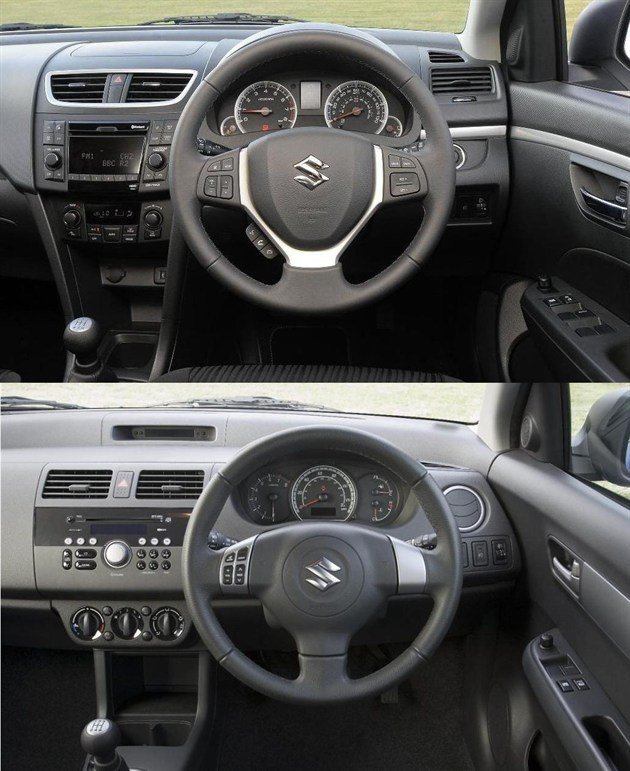
Indeed, the only areas in which the new car loses out, really, are boot space and acceleration. The boot is two litres smaller, and the car takes 1.3 seconds longer to reach 62mph from standing – something unnoticeable in practice.
If those differences are deal breakers then there must be something wrong! See below for a direct comparison of the key statistics.
What's good:
It's more efficient: The new model is more efficient than the old model, meaning fewer visits to the pumps and cheaper annual road tax bills.
And what's not:
Dulled performance: It takes slightly longer for the new model to hit 62mph. Having said that, it still feels... swift.
|
|
Suzuki Swift 1.3 SZ4 (2005) |
Suzuki Swift 1.2 SZ4 (2010) |
|
Combined economy |
49mpg |
57mpg |
|
CO2 emissions |
140g/km |
116g/km |
|
VED band |
E (£110 annually) |
C (£30 annually) |
|
Power |
92PS |
93PS |
|
Torque |
85lb/ft |
87lb/ft |
|
Top speed |
109mph |
103mph |
|
0-62mph |
11 seconds |
12.3 seconds |
|
Kerb weight |
1065kg |
1020kg |
|
Length |
3695mm |
3850mm |
|
Width |
1690mm |
1695mm |
|
Height |
1500mm |
1510mm |
|
Wheelbase |
2380mm |
2430mm |
|
Boot space |
213 litres |
211 litres |
That's interesting...
Having spent a while with the Swift I've started to pick up on things you won't notice in the showroom or on a test drive.
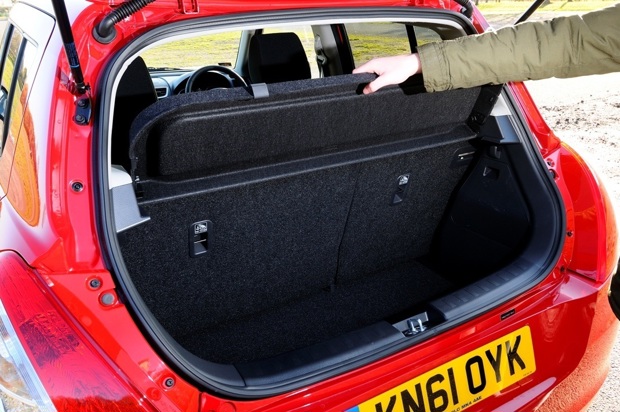
Date: 10 February 2012 | Mileage: 2016 | Claimed economy: 56.5mpg | Actual economy: 46.2mpg
When testing a car for the first time, the biggest things strike you first. You notice the ride quality, the performance, the handling and the comfort, as you’d expect, and that’s what really matters when you buy a car anyway.
But living with one means you start to notice the things that aren't obvious from just a test drive or a visit to a showroom. I’ve spent long enough with the Swift now to start noticing things like this myself. Some are nice touches, some are curious and some are a little frustrating...
The parcel shelf
The boot on the Swift is fairly small and that’s something you’ll notice right away. It’s fine for a small hatchback though. The thing that bugs me about it isn’t the size, it’s the parcel shelf. There’s nothing connecting it to the tailgate, so when you open the hatch, it stays in place and obstructs your access, so you have to fold it up manually.
Unfortunately, if you don’t remember to fold it down again it obscures the view out of the back. It won’t drop down under acceleration, so you’ve got to stop and put it back. It’s also got a sharp underside and it once drew blood when I was folding it back into place – although I think that was a problem with my particular parcel shelf rather than with them all.
The fuel gauge
This is curious rather than annoying. When I fill the tank up I always brim it to the top. It’s got a fairly decent sized tank with a long range, but the trip computer gets really confused about how far I can travel.
After brimming the tank it tells me I can travel about 360 miles until I’ll need to fill up again, but it continues to tell me that I can travel that far for another 70 or 80 miles, and then it starts to reduce. This is probably because the fuel level sensor is low down and the filler neck is long, but I can’t tell without dissecting the car - and I don’t want to do that.
Storage
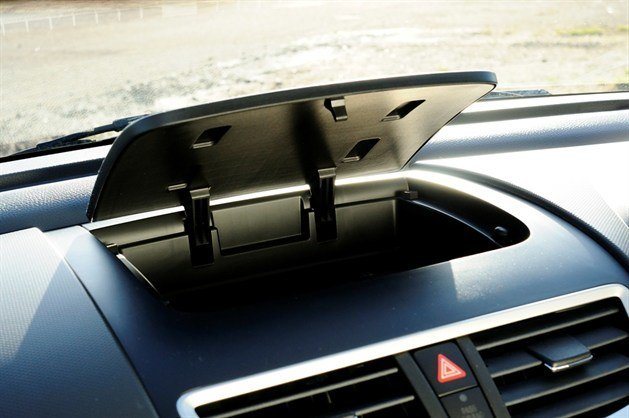
Suzuki’s home market is Japan, and they’re also pretty popular in India – both nations of small car buyers. That means Suzuki knows a thing or two about making small cars feel big, and one of the most important things to get right is storage space – and the Swift has lots of clever little bits.
The door bins are a decent size, there’s a cup holder for the rear passengers and space under the centre stack for a drink plus lots of odds and ends. The glovebox is a decent size too and there’s a handy storage bin in the top of the dashboard, although coins rattle around in it if you don’t put a non-stick mat in there.
Bluetooth
Bluetooth, an expensive option on some executive cars, is standard on the Swift SZ4. It comes in handy, offering a way of streaming music as well as allowing you to use your phone when on the move.
The problem is, I couldn’t set it up. Well, that’s not true, actually: I could set it up, but I had to use the manual, and I don’t like using the manual. That probably says more about me than the car, doesn’t it?
What's good:
Most things: It's never anything but a pleasure to drive the Swift. Getting in and going for a drive, even if just to get a loaf of bread or a bottle of milk, is enjoyable.
And what's not:
It cut me: Well that's pretty self-explanatory, really. A cut finger is never enjoyable. Having said that I doubt it'll cut anyone else, and I doubt it'll cut me again either!
Top accessories
I pick out some of the best - and worst - optional extras from the accessories brochure.
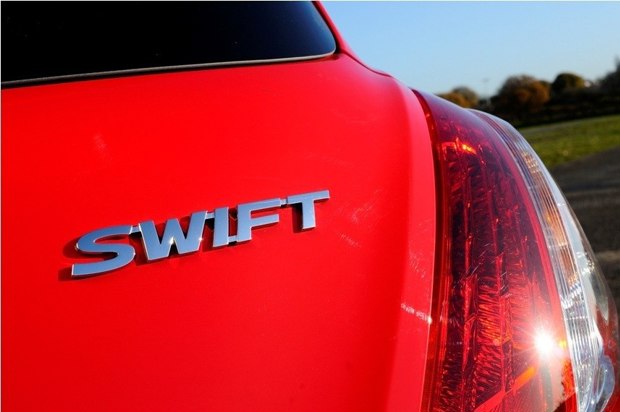
Date: 17 February 2012 | Mileage: 2101 | Claimed economy: 56.5mpg | Actual economy: 46.1mpg
The Swift comes with a lot of standard kit – you can read about it here – but what if you want a little bit more? Well there’s a whole catalogue of optional extras to enhance practicality, security and style. I’ve picked out five of my favourite optional extras – as well as a few to avoid.
Black Leipzig alloy wheels
Most of the trim levels come with alloy wheels, but unless you ask you’ll get the standard ones, which are pretty enough to suit most tastes – but I like to stand out a little bit, so I prefer these black ‘Leipzig’ alloys. They don’t come with tyres, though, and they cost £153.19 each... so if you fancy them you’ll need to add a fair bit to your budget.

Locking wheel bolt set
If you’re gonna spend a small fortune on fancy alloy wheels then you might as well fork out £25.54 for some locking wheel bolts – that way you won’t end up with them getting stolen. They’re Thatcham approved and come in a nice little red box.
Sports body styling
There is, of course, a Suzuki Swift Sport, but if you’re not a speedy driver and you still want good looks you can specify all sorts of stylish extras, including a diffuser style rear bumper for £415.86 (or £504.86 in a snazzy gloss black), a boot spoiler (£328.15), side skirts (£379.38) and a deeper front spoiler (£416.93). If you like the rally look, you can get a set of mudguards, too.
Centre arm rest
I often have to travel a long way so I appreciate a comfortable car and things like a centre arm rest can really help relieve tired arms and make a journey more bearable. This one costs £158.14 and doubles as a storage bin.
Boot protection
The Swift doesn’t have a big boot and thanks to a fairly high sill it’s quite tricky to load up. A boot sill protector, made from stainless steel and priced at £53.03, keeps everything safe if you regularly load heavy objects. There’s also a rigid moulded boot liner, which is ideal for carrying dirty things like garden waste because it keeps the carpet in pristine condition. It costs £32.60.
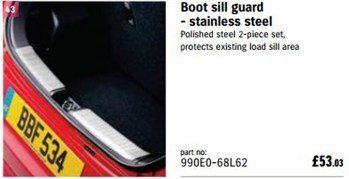
Besides these five options there are plenty more, including child seats, rear sunshades, door sill protectors and spare bulbs, but some of the options don’t really make much sense – or aren’t to my taste...
Tow bar
If you’re going to tow something then your best bet is a manufacturer approved tow bar – but the Swift isn’t really designed to tow. It doesn’t have much low down torque and it’s very light, so pulling anything other than a small trailer would be hard. Not only that, but it messes up the handsome styling!
Pioneer multimedia unit
It’s nice to have a high quality audio system. This one offers a touch screen interface and sat nav, so it has all of the bells and whistles, but it costs £1858.20. For that you could buy several portable sat navs - they can be moved from car to car and it's cheaper to update them.

Ashtray
For £29.62 you get a small piece of plastic for your cigarette ash. If you don’t smoke there’s no point in getting an ashtray because it sits in a cupholder, which is already there and provides ample storage for coins and other junk. So this really is just for the smoker, but smoking in a car is bad news – it can knock hundreds off the resale value.
What’s good
Options: There’s a lot of optional extras, with something to suit all tastes.
And what’s not
Underuse: I’ve not really added much mileage lately, because London isn’t the most car friendly city.
Where has the Swift been?
You never can tell where your car is going to take you, so I've highlighted some of the journeys that test the Swift's versatility on a map.

Date: 2 March 2012 | Current mileage: 2234 | Claimed economy: 56.5mpg | Actual economy: 46.3mpg
When buying a car you'll consider your regular routes and the most common journeys you’ll make. This could be the school run, your commute to work and trips to the shop. Of course, this is best way to pick a car. There’s no point buying a two seater if you have three kids to take to school.
But there’s no accounting for the unexpected and so you’ll almost certainly make a trip to somewhere you weren’t planning on visiting, or you’ll use your car for something you didn’t initially consider, like carrying a large load or crossing a wet field.
So I’ve picked some of the journeys I’ve made in the Swift, both everyday and unusual, and plotted them on the map below. Click the coloured routes for a description of the journey and an overview of how the little Suzuki managed.
View Where has the Suzuki been? in a larger map
Where does the Swift come from?
When you order a car you probably think nothing more until it's ready - but what happens between signing the papers and taking delivery?
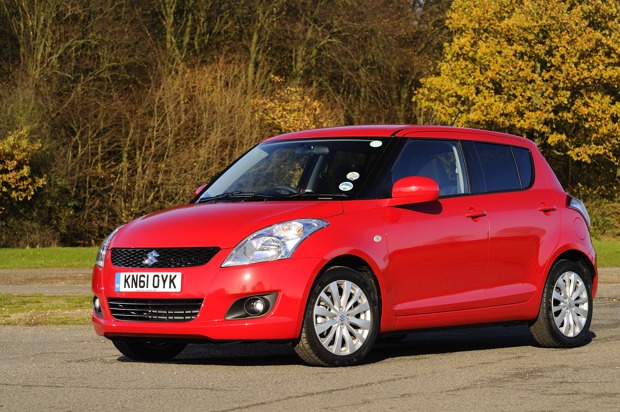
Date: 16 March 2012 | Current mileage: 2234 | Claimed economy: 56.5mpg | Average economy: 46.3mpg
If you decide to order a Swift then you’ll turn up at the showroom, have a test drive, spend some time choosing the trim and then you’ll wait a while. After a month or two it should arrive at the dealership and voila, off you’ll go into the sunset feeling happy with yourself.
But what happens between signing all the forms and the car turning up? Where is it made and how does it get here? Despite the fact Suzuki is a Japanese brand, European Swift models are produced at a plant in Hungary. There are also factories in Asia but they produce cars for the Asian market in slightly different trim levels.
Once the factory receives the order sheet for your car, which will include the colour, trim level and any factory fitted options, they’ll get to work. Production starts with bare metal, which is stamped and welded by machines.
Robots don’t do all of the work though – some of the assembly is carried out by humans. Things like trimming, routing wires and final checks are all carried out by factory workers. Not all of the car is built in Hungary, either – some components are brought into the country pre-assembled, including the engine, which is still made in Japan.
View Car factories of the world in a larger map
Once the car is complete it’s taken on a quick run to make sure it’s been screwed together properly and that it goes around corners, stops and starts. Then it ends up in a giant car park where it waits to be loaded onto a transporter and taken on the long trip to the UK.
If you’ve picked some fancy wheels, a spoiler, a body kit or one of various other options from the accessories book, they probably won’t be fitted at the factory. Most of the Suzuki Swift extras are ‘dealer fit,’ and are installed at the dealership – so even when your car is in the country it might not be finished.
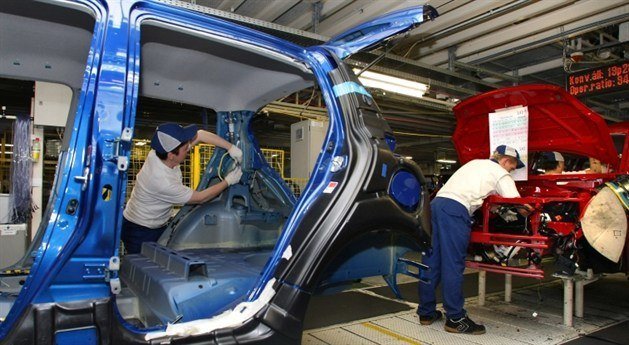
Once all of those are screwed on the car is checked, registered, taxed and has its numberplates fitted. It will probably be given a good buff up too. Then you’ll get the exciting call to you let you know it’s ready!
It’s quite a long process and there are lots of steps along the way, so it’s easy to see why it might take some time to get the car you’ve ordered. You might be lucky, though – sometimes the car you want will be in stock in the UK, either because of a cancelled order or because it’s a popular choice, and this cuts down waiting times.
What’s good
The Economy: The warmer weather has brought a gradual improvement in average fuel economy.
And what’s not
Where's sixth?: Having spent a lot of time on the motorway lately it's slightly annoying that there's no sixth gear. It'd improve fuel economy and make it quieter.
A potted history
It may seem a new name, but the Swift's history can actually be traced back to the early 80s. Can you remember all the models?
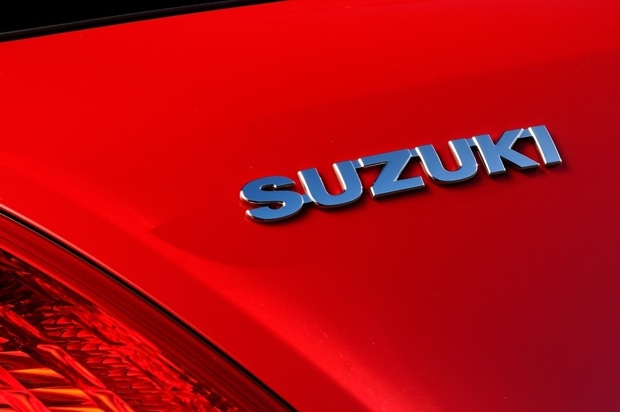
Date: 2 April 2012 | Current mileage: 2397 | Claimed economy: 56.5mpg | Actual economy: 46.3mpg
The current Swift is proving a popular car, as did its predecessor – but it’s has been around for a lot longer than you think. In fact, if you trace the Swift back to its earliest incarnation you’ll find it’s been on the go since 1983.
The first ‘Swift’ wasn’t actually a Swift – it was called the Cultus in Japan. Much like the current model, this version was offered as both a three and five-door hatchback. It was powered by a 1.0-litre three-cylinder engine with about 50PS.
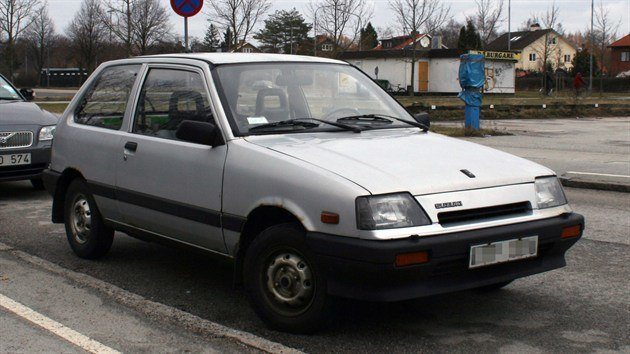
Sounds like it was slow, but it was tremendously light by modern standards, so could hit 62mph in about 14 seconds. The first generation Cultus wasn't sold in the UK until the mid-80s though. Most were sold in Japan, with some in the USA and Canada.
The next generation Cultus is more familiar, because it’s the first Swift we ever saw in real numbers in the UK. It was still called the Cultus in its home market and it was popular all over the world. In fact, it’s so popular that it’s still in production in India. It wasn’t so well received in the UK though, perhaps because of the quality of its rivals.
It’s been sold as a Geo Metro, a Pontiac, a Holden, a Chevrolet, a Subaru, a Maygar and of course a Suzuki, with its platform adapted to offer a variety of engines from 1.0-litre to 1.6-litre. Some versions even had four-wheel drive!
The next model to bear the Swift name was only sold as a Swift in Japan – everywhere else got the Suzuki Ignis, a square-sided model which looked a bit like a shrunken SUV. It offered a decent amount of entertainment in 1.5-litre Sport trim, though, and even provided the basis for a rally car.
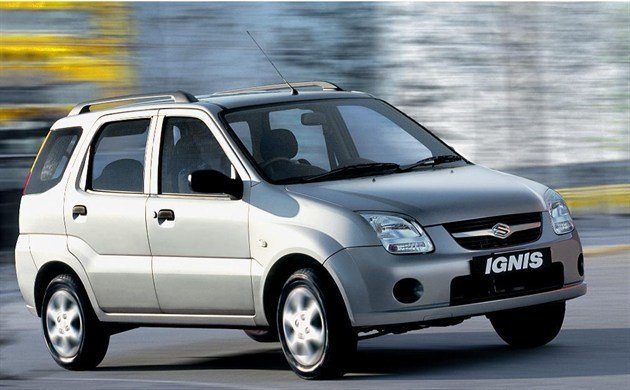
Next up was the 2005-2010 model Swift, which is a very familiar sight on UK roads. Aping the MINI’s style without being a complete copycat, this generation of Swift offered good value for money, low running costs, reliability and practicality – much like the current model.
In 2010 the current version was launched, and after the success of its predecessor it didn’t have quite so much work to do, so it’s a familiar shape, with improvements in key areas. You can read a comparison between the current and previous model here.
Better weather, better car
Most of the time I've spent with the Swift has been in the cold of winter but now the sun is out the Suzuki is much more enjoyable to drive.
Date: 4 May 2012 | Current mileage: 2814 | Claimed economy: 56.5mpg | Actual economy: 47.9mpg
The Swift first turned up on my driveway in November, so most of the time I’ve spent driving it has been in the cold darkness of the British winter. Snow and ice can be bad for a car, but even without either of those the winter isn't much fun for motorists.
First of all there’s the cold temperature, which increases fuel consumption. There are various reasons for this, including increased friction because engine oil is thicker at low temperatures. Tyre pressures are also slightly lower in cold weather because air is denser at low temperatures and this increases rolling resistance.
On top of that, fuel doesn’t burn as readily in the cold as it does in the warm. This, coupled with the fact the engine was still in its running in phase, meant that over the winter my fuel economy tended to hover around the 46mpg mark. Rarely did it rise above it.
Cue clement weather and there was a sudden improvement to almost 48mpg. If I cruise along in a 50mph zone it rises further still – so it seems the economy agrees with summer time. Not only that but the car just ‘feels’ better in warmer weather.
This year I didn’t have winter tyres fitted, contrary to my own advice. While there were never any slippery moments during the colder period, now it’s warm again the Swift feels almost like its riding on glue. The steering is very precise and the Swift can tackle corners much faster than you’ll ever need it to without breaking a sweat.
The air-con is better at keeping you cool than it is at keeping you warm too. In the winter it needs constant fiddling to maintain a comfortable temperature and takes quite a while to heat up on a chilly morning. In the warm it just ticks away, and it doesn’t seem to affect the fuel economy at all.
None of this is to say that the Swift is bad in winter, of course, it just feels much more at home in warmer weather, as do most cars. It's just a shame that the next update will be my last, as the little Suzuki is will be leaving us in just a couple of weeks.
Farewell, Swift
Six months and 6500 miles have passed since the Suzuki Swift first arrived but now it's time to say goodbye. So how has it fared in its time with us?

Date: 7 June 2012 | Mileage: 6892 | Claimed economy: 56.5mpg | Actual economy: 48.1mpg
When the Suzuki Swift arrived in November last year, resplendent in red, I was surprised by how much equipment it had. In SZ4 trim there’s everything from Bluetooth and cruise control to keyless entry and start – and that first impression has been a long lasting one. Having spent six months driving it, taking in towns, cities, country lanes and motorways I’ve grown quite accustomed to the various gadgets. They're the car’s strongest selling point.
Keyless entry and go is particularly handy – merely having to press a button on the door in order to unlock them is a boon, especially when it’s a cold day and you’re carrying heavy bags. There’s no fumbling in your pocket and it becomes second nature that you occasionally find yourself forgetting about the necessity of keys when it comes to getting in and out of the front door at home.
Similarly, cruise control has become so useful to me, given my regular long journeys from London to the North East, that I think I’d feel a little lost without it. It makes life incredibly easy when the motorway is quiet and is especially handy when there's a 50mph zone to navigate, of which there seem to be increasingly many. The easy to tune radio and USB connectivity also make the tedium of the motorway pass more enjoyably.
They haven't been the only impressive features though. Fuel economy has been good, with the final average figure standing at 48.1mpg. This is short of the claimed figure of 56.5mpg, but as that’s established in a laboratory it’s fair to expect a real life figure to fall a little short. The Swift’s also been an enjoyable car to drive, with fun handling on B-roads and lively performance from the 1.2-litre 94PS engine.
It’s not all been great news, though. The long motorway cruises would have been a lot more pleasant of there was a sixth gear, because at 70mph the engine can be a little loud and intrusive. Plus while the cabin is handsomely styled and pretty well screwed together, some of the materials feel a bit cheap. Finally and most frustrating, is the rear parcel shelf, which you have to consciously pop back into place after loading. If you don’t it blocks your rear visibility entirely.
Overall though, the car has been impressive. It’s frugal, well styled, enjoyable and reliable. With its good level of standard equipment it’ll leave those people in the market for a small hatchback wanting for very little.
The chart below is interactive and shows some of the statistics from our six months with the car, including mileage, fuel economy and costs. Click the bubbles for more details.

